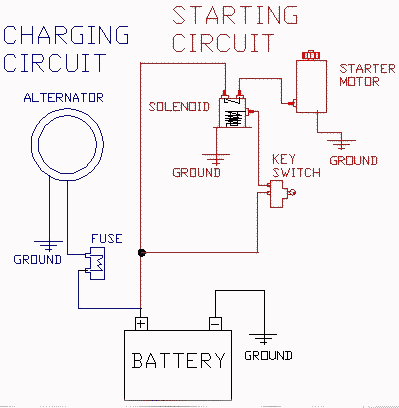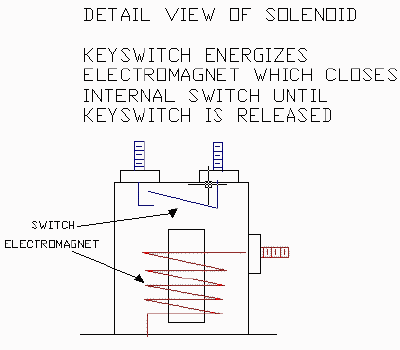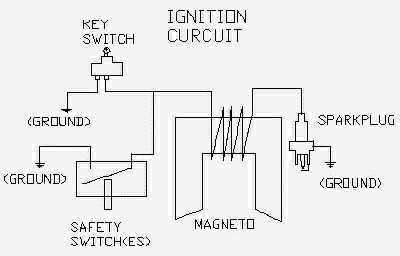Small Engine Repair: Free Help
Your machine will not start or runs poorly? Try these tips before you take it in for service. READ YOUR OWNER'S MANUAL. Remember that our service manuals quickly pay for themselves. The step by step troubleshooting procedures eliminate guesswork and show you how to fix it right the first time. Small engine repair and lawn mower repair make great do it yourself projects.
 |
Gasoline can ignite very easily. Work only in well-ventilated areas and away from sources of heat, sparks, and flames. Always wear safety glasses, and be careful of sharp blades. Keep a fire extinguisher nearby.
|
Trouble Diagnosis Procedure
If you follow these easy steps in order, you will be able to locate the
problem. This is the same procedure we follow when diagnosing engines.
A word of caution here: We have developed
this method over many years and recommend that you do not assume
the trouble is a certain part, as a problem in one area will often
show up as a symptom somewhere else. An
example is carb malfunctions are often incorrectly assumed to be
governor problems. Let's roll up our sleeves and get to
work!
Decide if it is worth repairing! Old worn engines are not
easily fixed as there is not just one problem, but a combination of
many problems! More serious problems such as a scratched or worn
bore, worn piston rings and worn valve guides are best repaired by
installing a shortblock or complete replacement engine.
Engine will not
start:
Most "it won't start" problems can be divided into two areas:
fuel related or ignition related.
- Be sure that the machine has an ample supply of fresh fuel. For
2-cycle machines that require it, mix the proper amount of 2-cycle
oil into the gasoline and shake to mix completely. Never use old or
leftover fuel. Store fuel in an airtight container in a cool, dry
place away from sparks and flame, and keep all vents on the can
closed . Bad gas is more common than you may think, especially
when starting a machine for the first time in a season. Do not
store gas over the winter, pour it in your car and start fresh next
year!
- If the engine is a 4-cycle, be sure the engine oil is the right
type, is clean, and is at the proper level.
Next step is to check for
spark:
- Make sure that the ignition switch is "on", that all
attachments are disengaged and that the transmission is in neutral.
Most machines have safety mechanisms that will not allow them to
start otherwise. Consult your owner's manual for the starting
procedure for your machine.
- Next- check for spark by removing the spark plug and grounding
the "hex" part of the spark plug to a bare metal part of the
engine. Remove any spilled gasoline that is nearby, then spin the
engine by pulling the rope or turning the key. You should see a
blue spark jump across the plug gap. If you have a good hot spark,
skip to the carb section.
- If the spark is yellow and weak, or there is no spark then the
first thing to do is try a new spark plug. Do not try to clean the
old one. Set the new plug gap to the proper spec (usually 0.030")
and check for spark again. If you do see a spark, install the new
plug and try to start the machine. If you still have no spark next
try cleaning and setting the points on older machines, or replacing
the electronic ignition module on newer machines. Before replacing
the old module test it by disconnecting all the wires from
the module terminal that connect to the kill switches and recheck
for spark, if you see a spark a wire or switch is defective.
Also check the flywheel key. That affects the spark timing, usually
the key will need replacing if you strike something while mowing
and the engine stops. We can provide the parts for
your ignition repair
Next step is to check the carb
& fuel system:
- If the machine won't start and the spark is good, you
must make sure that fresh gasoline is getting to the carb. Make
sure that the fuel shutoff valve (if present) is opened, and
that the fuel line is not plugged or kinked. Also be sure the fuel
cap vent is open and any screens in the tank are clear of debris.
If fuel can flow to the carb, carefully place 1 teaspoon of
gasoline down the spark plug hole (or a add shot of starting fluid
into the carb throat). Re-tighten the plug and try to start the
machine. If it runs for a second or two, then quits, chances are
the carb needs to be serviced (disassembled and cleaned &
inspected, then rebuilt) or you have an air leak somewhere. Make
sure all mounting screws or bolts are snug and gaskets are not
missing sections. If the carb is a bowl-type check for water in the
bottom of the bowl (but do not let the float
swing all the way down or the float needle will fall out!).
It is easy to install a carb kit
yourself.
Engine will
start but runs poorly or dies:
ENGINE STARTS AND DIES, SURGES, OR WILL
ONLY RUN ON CHOKE
Carburetor problems produce different
symptoms. There are many different types of carbs, but they all
operate the same. The main types are the bowl and diaphragm.
For info specific to your carb, we recommend that you purchase the
proper repair manual for your engine. The manual contains exploded
views of the carb, to help you get it back together properly the
first time. They also contain diagrams of where the linkage goes,
cleaning and adjustment procedures, and help you to spot worn
parts. Most often a manual and a carb rebuild kit are cheaper than
1 trip to the shop. General problems and solutions are presented
here, but due to the many variations of carbs out there, if you
remove the carb, or disassemble it, be sure to write down how it is
set-up now, to save fumbling later! No matter what type you have, a rebuild kit is inexpensive
and will cure 90% of all carb problems. The first thing to do if
the engine will run but acts funny is to try to simply adjust the
carb slightly. Note the position of the screws now, in case you
have to return them to the original positions. It is recommended
only experienced do-it-youselfers attempt carb repair with out a
manual.
- Bowl-type carbs: Runs then dies: Check
for stuck float, plugged fuel filter or fuel line. All tanks have a
screen inside them to catch larger particles, and some also have a
inline fuel filter. If everything checks ok, the passages inside
the carb are plugged, follow the cleaning procedure outline in the
manual to be sure you only have to do the job once!
Surging, only runs on choke,
sputtering: Is the air filter
dirty? With the bowl as the lowest part of the fuel system, any
dirt or water will wind up here. Turn off the fuel valve, or drain
the gas tank, then place a rag under the bowl to catch the gas that
will run out. Loosen the "nut" that holds the bowl on, and after
the gas has stopped draining remove the nut and bowl, but do not let
the float swing all the way down! Wipe out the bowl. The "nut"
usually contains 1 or 2 very small passages, soak in (or
spray with) carb cleaner and use a wire bread-tie or other soft
wire to poke out the holes. Blow out with compressed air, if
available. Put the bowl back on and try to start it. If it still
will not start, it needs a good soaking and a rebuild kit.
Drips, or crankcase fills with gas: Check the float first.
Remove the carb, and then the bowl. Remove and shake the float, it
should not be full of gas, if it is, replace it. If it is ok
then the float needle/seat assembly should be replaced.
- Diaphragm type carbs: They are less prone to trouble as a rule. Hard
starting, or will not start: (spark is ok) The diaphragm may
act as an auto choke or a fuel pump. It is made of rubber and will
harden over time and no longer flex. It is the first thing to
replace. Next check the fuel pick-up tubes for blockage, the
check-balls in the pick-up tubes for free movement, and the tank
for water. If it still is acting up, install a rebuild
kit.
MISC. ENGINE
PROBLEMS
- Oil smoke or leak near the
carb: The drain holes in the
breather cavity (or breather cover on some engines) may be plugged.
Access the cover and remove it. Wipe the cavity out and poke a
small wire down the hole in the bottom, and check the cover for a
small hole, and clean it out. The hole must be down when the cover
is reinstalled. A new gasket is also required.
- Oil leak near the base of the
engine: Most likely the fill
tube o-ring is loose, loosen the dipstick and push down firmly then
retighten. If that fails the sump gasket is loose or missing a
small section.
- Oil smoke thru the muffler: All the time -worn rings.
Stops shortly after starting -worn valve guides.
- Backfires thru carb or air filter: Intake valve not
seating properly, check lash and/or reface valve & seat.
- Kicks back when starting: Flywheel
key is nicked, or, on points-type engines, the condenser is
defective or point gap is too small.
- Starter rope will not retract or is
hard to pull: Usually the rewind spring or spring anchor points
are broken. The starter must be disassembled and the parts
inspected. Remember the spring is
under tension! There are
many different types of starters, and a manual is a good idea if
you are not familiar with them. If the starter is hard to pull,
remove the starter and then try it, if the starter is ok off the
engine, check the engine itself for for seizing or oil-locked
cylinder. Remove the plug and pull rope -if it will now spin and
oil blows out the plug hole then carb is leaking into sump or
engine has been tipped for a long time.
- Starter rope broke: On some types
you must disassemble the starter to replace the rope, on others you
simply wind the pulley up until it stops, back off 1 revolution and
poke a new rope thru the hole in the housing and then into the
pulley, tie a knot and slowly let the rope pull in.
- Compression low. The most common cause of
compression loss is the valves. Worn guides, warped, pitted, loose
or burned seats, and improper lash are common valve problems.
Backfiring through the carb is one symptom of valve trouble. If the
valves are operating properly and the compression is still low,
worn rings or bore are best fixed by installing a rebuild kit,
shortblock or complete replacement engine.
- Won't start when hot: If the engine spins too easily
check for valves that are sticking open. If compression seems ok,
then check for spark as detailed at the top of this page.
Solid-state ignition modules commonly cause this problem when they
start to fail.
BATTERY CHARGING
PROBLEMS
- If the battery will not hold a charge: The problem is
either a bad battery, or a problem in the charging circuit.
First, charge the battery. If it is at all low, it will not start
the engine. Clean all connections, corrosion is 80% of all
electrical problems. Check that the fuse is not blown. In the
wiring harness somewhere there is usually a fuse, look under the
dash (If it is a push mower, there may be no fuse), or follow
the wires the come out from under the flywheel. There will be a
fuse holder & fuse. The battery should read 11-13 volts (push
mowers may be 6 volts), check it with a voltmeter and record the
reading. Then check the battery voltage with the engine running (if
possible) it should be higher, about 13.5 volts (7-8 volts for a
push mower) if it is, the charging circuit is functioning. The
typical battery lasts 4 years. Most auto parts stores will
load-test it for free, but charge it first for an accurate
reading.
- If the engine cranks too slowly, but all the above tests
are passed, the problem may not be the starter, but too much drag
on the engine. Try to turn it by hand... it shouldn't be too
difficult. If it is very hard to spin, check that the deck is not
engaged and that the transmission (if any) is not tight. With the
tractor or mower OFF, put it in neutral and try to push the machine
forward. It should move with moderate effort. Next, disconnect the
spark plug wire and try to turn the blades by hand. They should not
be tight. If they are tight, the problem is a bad belt or bearing,
or grass buildup. If everything checks out, the starter motor
itself it the problem. Look for worn brushes, seized bearings, or a
burned commutator.
- If the starter spins, but doesn't engage the engine: The
gear that engages the flywheel is stuck or broken. Try to pry it
upward towards the flywheel gently, then oil the starter shaft. If
that doesn't help, replace the gear. Also check the flywheel ring
rear for broken or worn teeth.
ELECTRIC STARTER WILL NOT
WORK:
- Test the solenoid: First determine the type of solenoid
you have: There are 2 basic types of solenoids. One has 3 terminals
and the other has 4. Two large diameter studs, and 1 or 2 smaller
diameter studs. The 2 large studs connect to the battery and to the
starter. The smaller ones are to the starter switch and the other
is ground (if the solenoid only has 1 small stud then the ground is
thru the mounting ears). To test: make sure the battery is fully
charged. Next, short out the 2 large studs with an insulated
screwdriver. If it cranks, the solenoid or starter switch is bad.
If it won't crank, the battery or connections are the problem,
clean all connections and try again.
- Test the starter switch: Connect a piece of wire to the
battery positive terminal and touch the other end to the small stud
that is marked "+" or "s". If it cranks, the starter switch is bad,
and must be replaced with the exact same type for proper
operation..
NOTE: These are typical circuit layouts for reference only. Yours may differ.


 Still stumped? Our Manuals, Videos and
CD-ROMs pay for themselves on the first job!
Still stumped? Our Manuals, Videos and
CD-ROMs pay for themselves on the first job!
All material on this site (C)
1994-2023 M&D Mower
|

